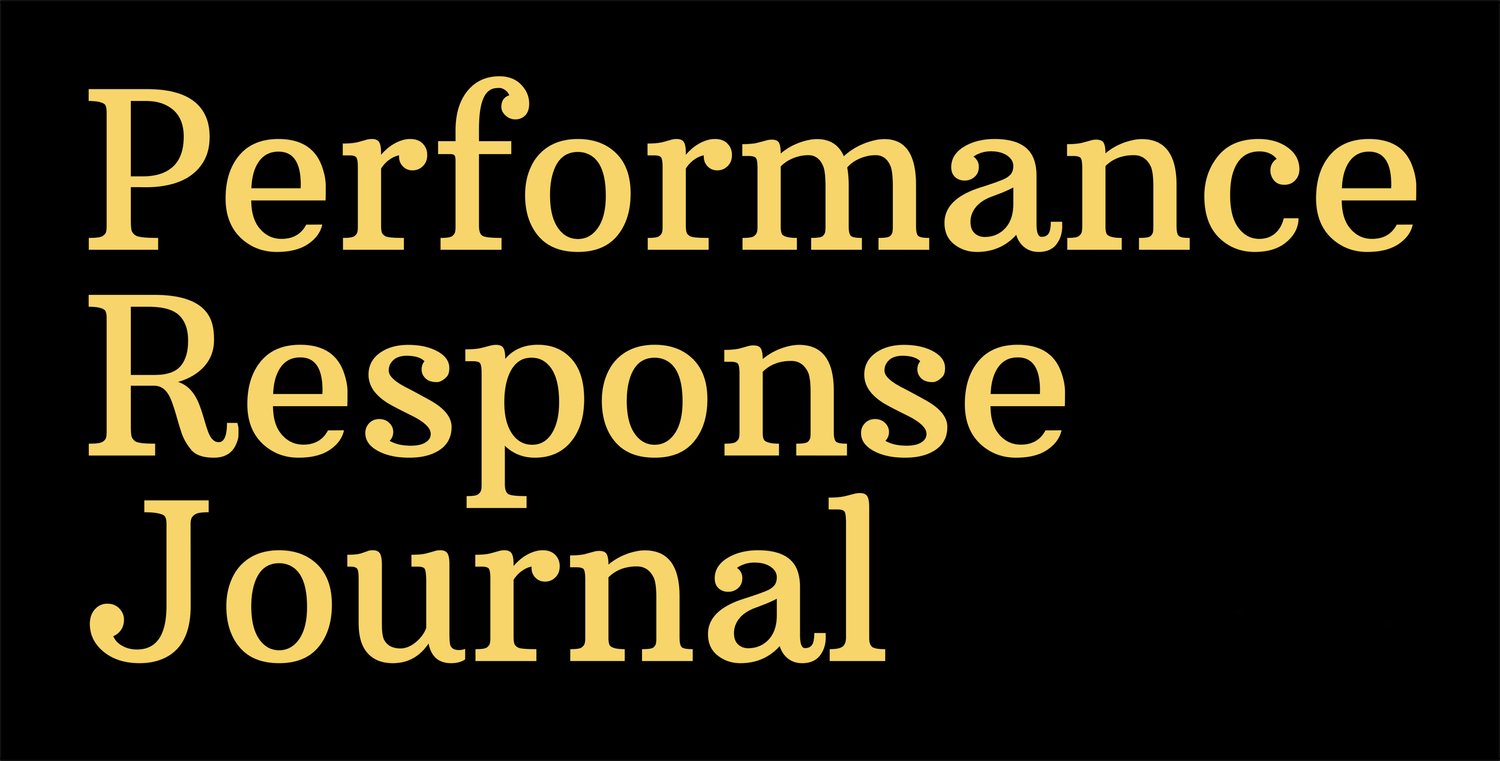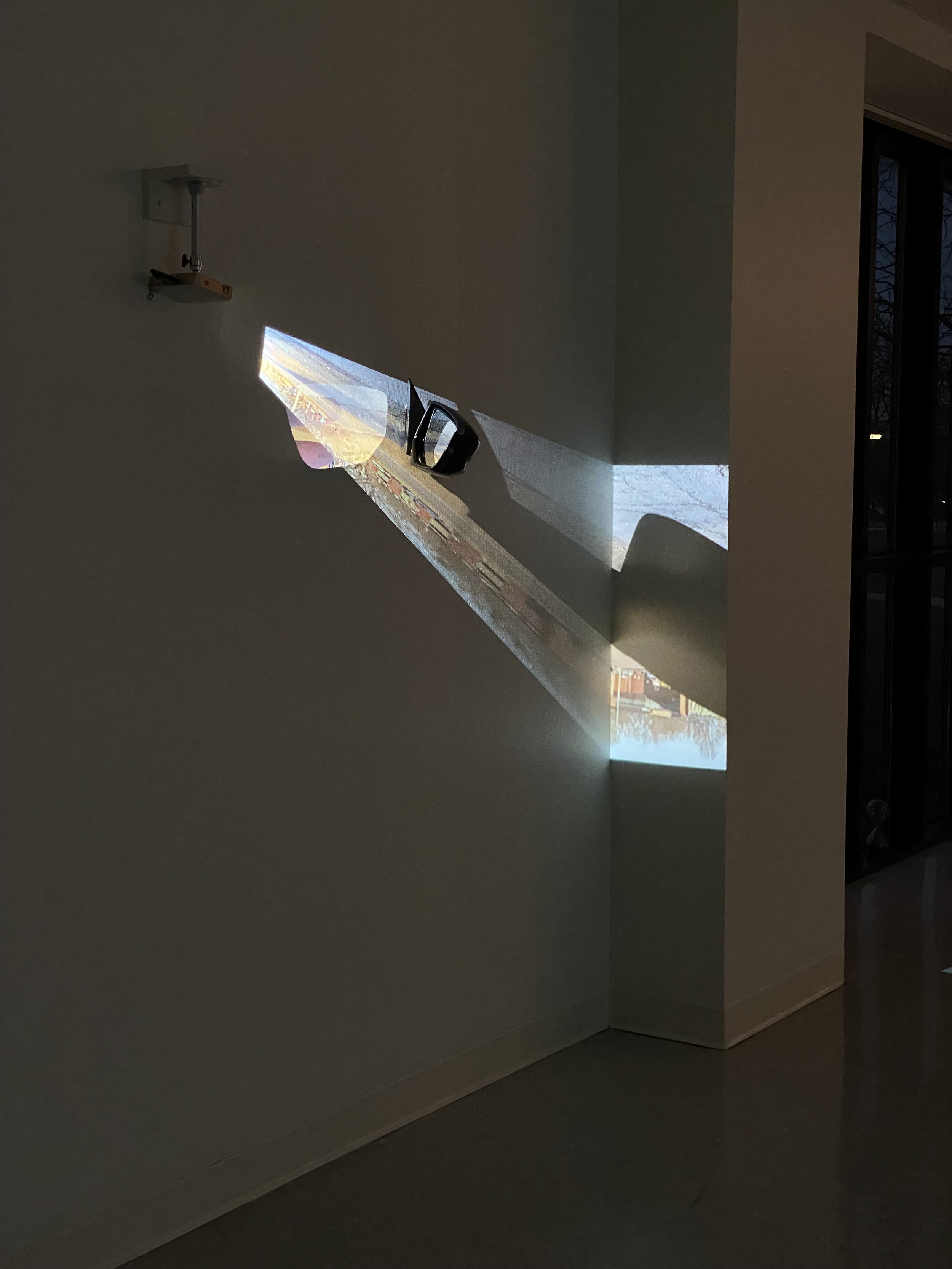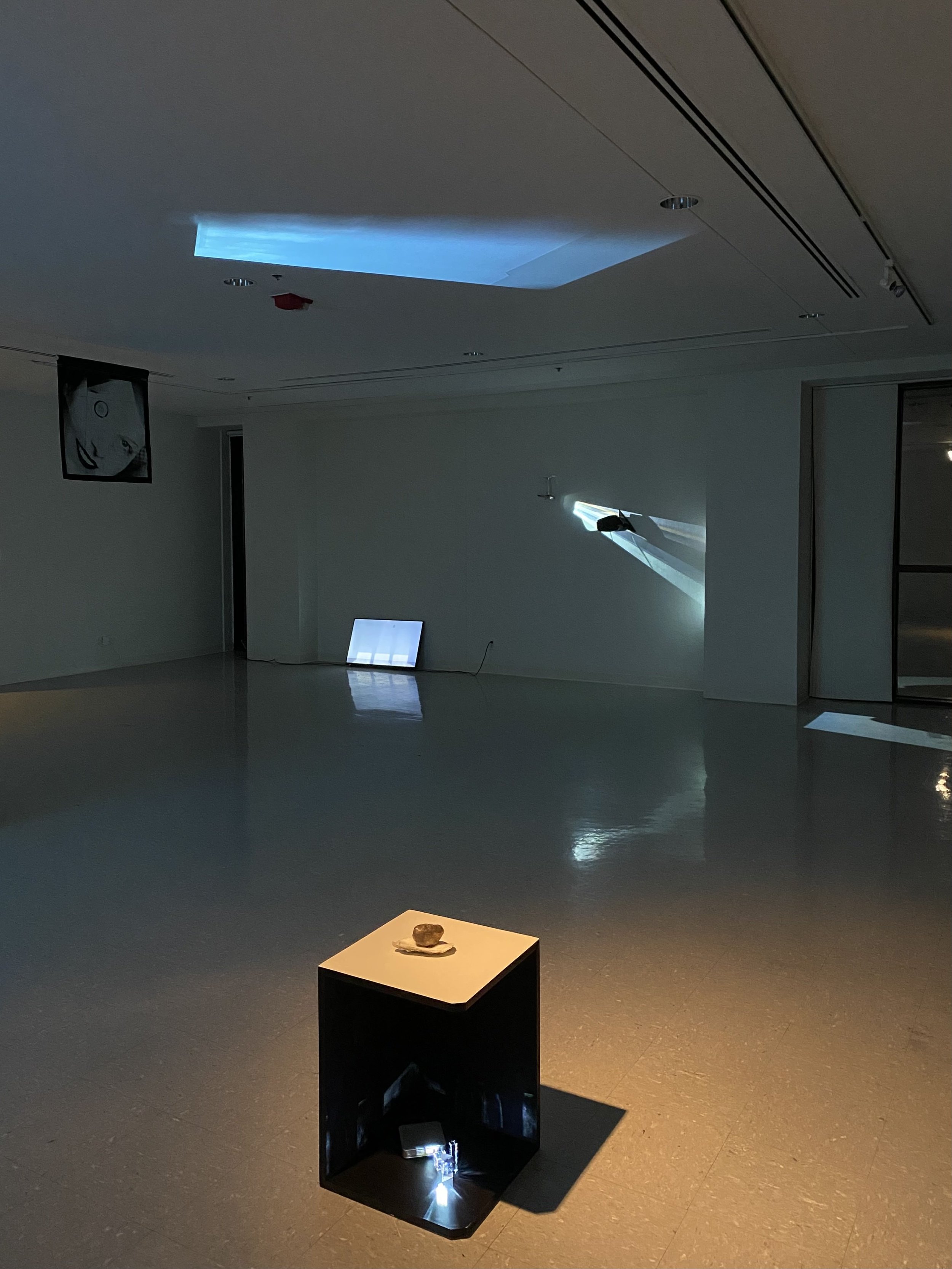Ruby Que’s Maintenance of Light: a response by Gabriel Chalfin-Piney
“Tired Light” by Ruby Que, 2023
“It is more arduous to honor the memory of anonymous beings than that of the renowned. The construction of history is consecrated to the memory of the nameless.” [1]
During a residency in Maine, Ruby Que spent hours watching the light move across their studio wall, chronicling the rising and setting cycles over days and weeks. Mimicking the sun’s refraction through the studio windows onto the walls, Que’s projection is cast onto the darkened studio wall, hours after the sun has set. A false sunset. Que would document the light moving and then at night they would project the light onto the wall for five hours before sunrise. They saw it as a sisyphean undertaking, circuitously drawn back by a remembered yearning, for a light that would not come again. I use the word rhizomatic [2] here as a placeholder for the infinite tendrils of disappearances in Que’s work; ever evolving paths, controlled by a seemingly choreographed guidance, produces a feeling—lights off in the theater.
Their art-making around disappearance, a labor of necessity, has iterated for nearly a decade throughout various residencies, installations, and bodies of work. Fake walls from stages and how they use light remains deeply bound by their theatrical roots. Que worked as an actor, director, lighting designer, and sound designer. Their entry into installation took place first during their thesis installation [3] in Cornell’s black box theater. The installation, typical of Que, was in darkness with spotlights, a parabolic speaker sharing stories, and projections spread throughout the space. Que encouraged people to come into the space and listen to the stories being shared and respond to the stories in writing, pinning them on the wall or placing private memories in fishbowls throughout the space. For the closing, Que invited a dancer to enter the space with a single instruction - destroy the space as much as possible.
A large part of Que’s day job is replacing projector lamps. As Que shared about this job, I saw no signs of resentment, instead, a continual learning and tenderness for the seemingly mundane task. They worked as a projectionist in college and obsessed over looking directly into the projector. People have said of Ruby Que that maybe they’re an archivist. They don’t think so. Que likes taking things apart, figuring out what’s wrong with them. They shared with me that the experience of maintaining projectors requires you to not treat them as just machines, but that they have their own temper that must be cared for. This is true not only of the analogue projectors covered in years of dust but also the new state of the art projectors. “I think I'm more like a maintenance worker or a repairman.”
Que shared with me about Ackbar Abbas and his characterization of Hong Kong as a city in perpetual disappearance, a city without a pre-colonial past. The discussion of colonialism almost doesn’t apply because Hong Kong was birthed by colonialism. Que talked about their walking and watching the light on top of the ocean during their time at another residency on a human-made landfill island. They spoke about living in Prague and the beauty of an abandoned train station that became a homeless shelter. Their smile beamed as they revealed their findings about the koi pond at the university where their current show resides. The koi are moved somewhere during the winter and no one seems to know where they go, and then come spring, they reappear.
Que described to me the upcoming performance, which will close out their solo exhibition "Consider A Disappearance," at the The University of Illinois-Springfield Visual Arts Gallery, on March 7th, 2024. They detailed duration, time, and maintenance, as well as the various projectors in their material cache, tools for world building in light and shadow. “I think there's a secret joy in me knowing that I've placed these things that are for you. You know, I found this environment for you.” Que shared with me their attachment to use and when intended use is betrayed. I see this goading trust, spritely deception, throughout much of their making. There is a unique form of honesty in their art: it calls for an unconditional faith, and answers: trust me I’ll show you where there is nothing, where you aren't going. There is shadow puppetry as you see limbs and appendages interacting with projections, ghostly in connectivity and chance, bodies in fabric-in motion, tiny experiments of Que’s handiwork orienting and designing spaces with precision.
The highly intimate and solitary nature of Que’s practice produces an effect in my body as I interact with their installations, I relinquish my talons—control—trusting Que to write the space as I step near and through threshold after threshold. There is a freedom of movement in Ruby Que’s installations. Their ability to repair and be in relationship with the untraceable nature of light one moment and to take it away the next moment is breathtaking. There are no traces of second guesses, there is a defined practice of balancing moments of destruction and repair.
“...at the beginning of the tunnel, the roof is closed, so it just looks like a box, but then, as you descend down the stairs the top opens up. So just this walkway. This passage—because Arcades Project [5] is all about passages and Paris—these shopping malls, with glass and steel, the symbol of modernism, as he calls it. So it opens up, and you can see the sky, and then you keep descending to the ocean. But then, right as you're about to touch the ocean—you can see the ocean, you can hear the ocean, you can probably smell the ocean—there's a glass panel separating you from the ocean. You can never touch it. You can never walk into it, even though it's right there…that gesture of promising people something all the way to the end is so cruel but also really beautiful.” [6] - Ruby Que
[1] Translated from German from Walter Benjamin's “On the Concept of History,’ etched in his memorial.
[2] I curse Deleuze for ever entering my consciousness before dropping out of Sarah Lawrence College in 2011.
[3] Ruby Que's HERE IS A PUDDLE was installed at Cornell University's Schwartz Center for the Performing Arts in 2019.
[4] Hong Kong: Culture and the Politics of Disappearance by Ackbar Abbas
[5] Arcades Project by Walter Benjamin
[6] Ruby Que speaking about "Memorial Passatges a Walter Benjamin" by Dani Karavan, built in 1994 in Pourbou, Spain.
Ruby Que’s solo exhibition Consider a Disappearance runs February 12-March 7, 2024.
“Consider a Disappearance” is presented in partnership with ACRE, an artist-run non-profit based in Chicago that is devoted to providing resources to emerging artists and nurturing a diverse community of cultural producers. ACRE’s programs support this generative community with materials, equipment, expertise, and opportunities to exhibit & share work.
In conjunction with this exhibition, the UIS Visual Arts Gallery will host a closing performance by Que from 4 to 6 p.m. on Thursday, March 7. All events are free and open to the public.
The UIS Visual Arts Gallery is centrally located on the UIS campus in the Health and Sciences Building, room 201 (HSB 201). Gallery hours are 11 a.m. to 6 p.m. Monday through Thursday.
***************************
Gabriel Chalfin-Piney is a Jewish-Quaker object maker and performer. World building, self taught artistic practice and multi-sensorial performance centers much of their work. They are the founder of the Jewish Museum of Chicago.
Gabriel Chalfin-Piney has shown work at Arts of Life (2024) Heaven Gallery (2024), Comfort Station (2023), Tiny Table Gallery (2023), Bird Show (2023), Speedwell Projects (2022), Buoy Gallery (2022), Chicago Artists Coalition, (2021, 2020), High Concept Labs (2019), The Samuel Dorsky Museum of Art (2017); and featured in ArtNews, New City Magazine, Spaces Archive, The Chicago Sun Times and The Chicago Reader.




